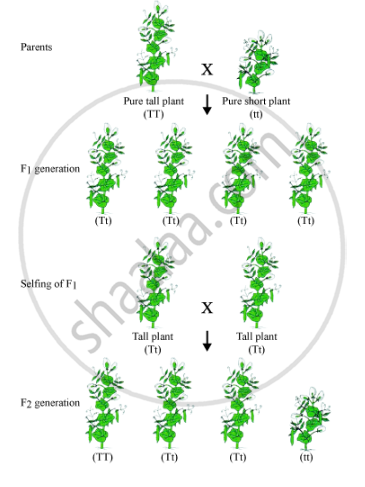Advertisements
Advertisements
Question
"A trait may be inherited, but may not be expressed." Justify this statement with the help of a suitable example.
Solution 1
Let us take the following example to justify the above statement.
Mendel crossed tall pea plants with dwarf pea plants.

Mendel's Observation
F1 generation contained all tall plants. When F1 generation underwent selfing, the trait that was unexpressed in F1(dwarf) was observed in some F2 progeny. Thus, both traits, tall and dwarf, were expressed in F2 generation in the ratio 3:1.
The above experiment indicates that although both the traits of tallness and shortness were inherited in F1 plants, only the tallness trait was expressed. This shows that traits may not show up in an individual but are passed on to the next generation.
Solution 2
Some traits are determined by the combined effect of more than one pair of genes. These are referred to as polygenic or continuous, traits.
An example of this is human stature. The combined size of all of the body parts from head to foot determines the height of an individual. There is an additive effect. The sizes of all of these body parts are, in turn, determined by numerous genes. Human skin, hair, and eye color are also polygenic traits because they are influenced by more than one allele at different loci. The result is the perception of continuous gradation in the expression of these traits.
APPEARS IN
RELATED QUESTIONS
How do Mendel’s experiments show that the traits may be dominant or recessive?
Name the information source for making proteins in the cells.
Mendel crossed tall pea plants with dwarf pea plants in his experiment. Write his observations giving reason on the F1 and F2 generations.
Mendel in one of his experiments with pea plants crossed a variety having round seed with one having wrinkled seeds. Write his observations, giving reasons, of F1 and F2 progeny
A Mendelian experiment consisted of breeding pea plants bearing violet flowers with pea plants bearing white flowers. What will be the result in F1 progeny?
Give the contrasting traits of the following characters in pea plant and mention which is dominant and which is recessive:
Yellow seed
Which of the following statement is incorrect?
(a) for every hormone there is a gene
(b) for every protein there is a gene
(c) for production of every enzyme there is a gene
(d) for every type of fat there is a gene
The term 'father of genetics' is used for the scientist :
(a) Morgan
(b) Mendel
(c) Darwin
(d) Marie Curie
One of the following traits of the parents cannot be passed on to their future generations. This trait is :
(a) cleft chin
(b) pointed chin
(c) scarred chin
(d) broad chin
What is genetics?
